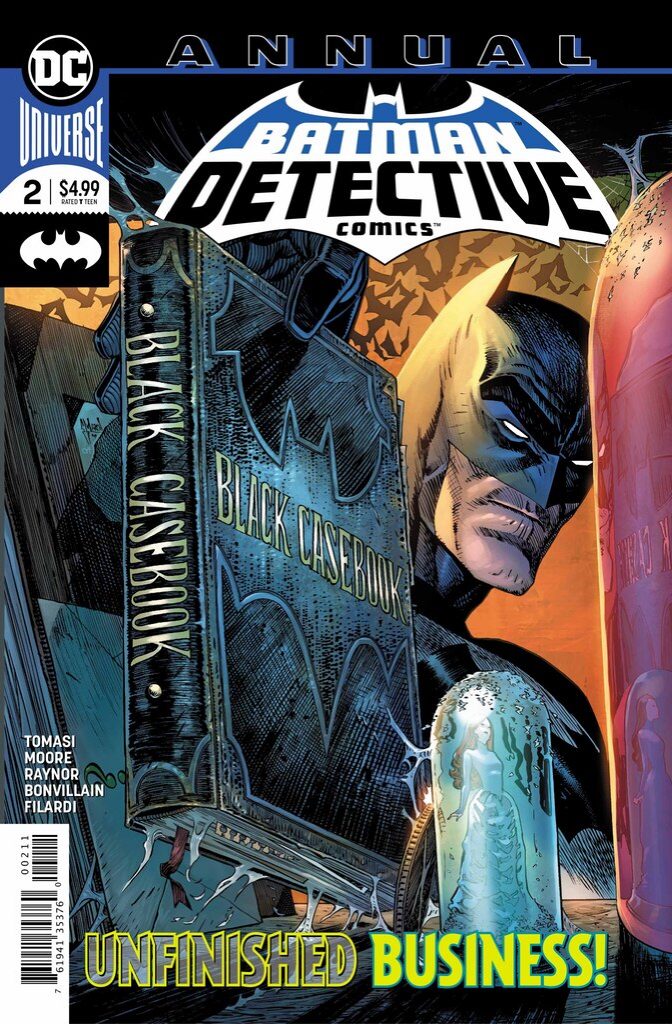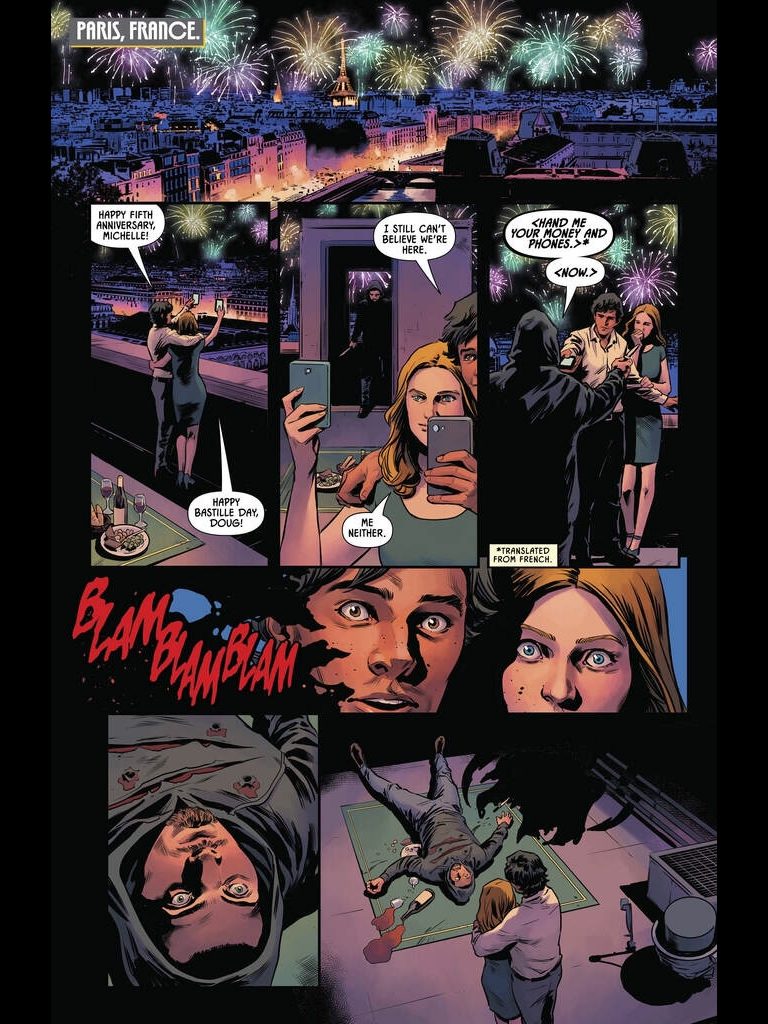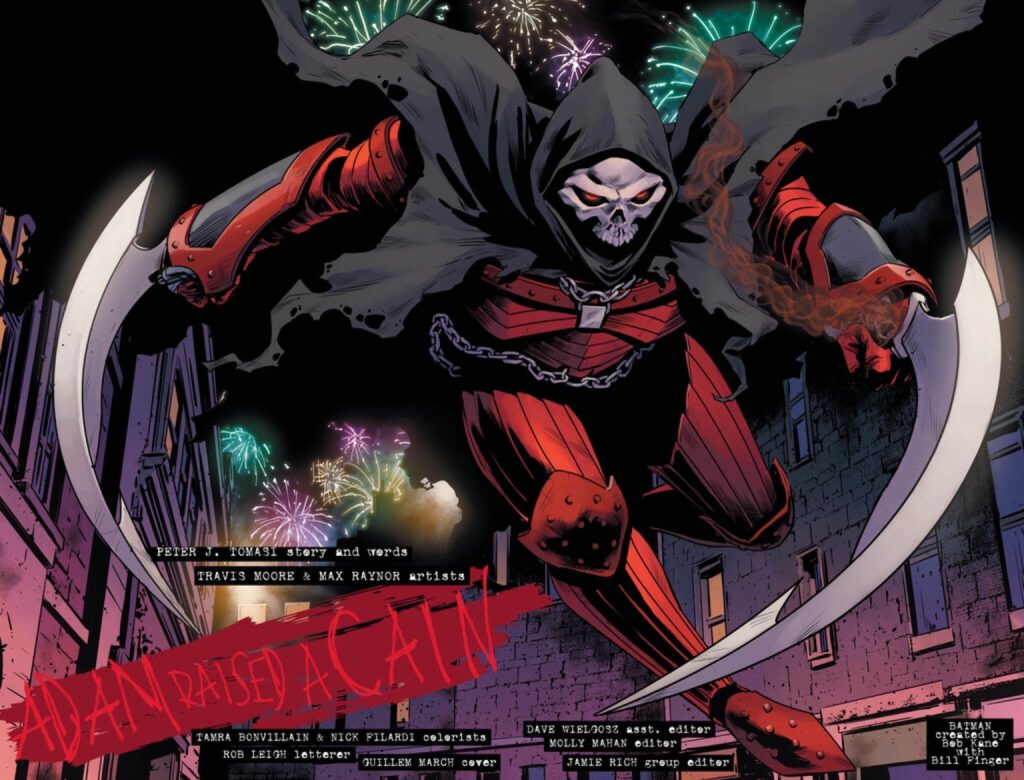Review: DETECTIVE COMICS ANNUAL #2

[Editor’s Note: This review may contain spoilers]
Writer: Peter J. Tomasi
Art: Travis Moore & Max Raynor
Colors: Tamra Bonvillain & Nick Filardi
Letters: Rob Leigh
Reviewed by: Matthew Lloyd
Summary
What makes a great comic book? Plot? Characterization? Humor? Nostalgia? Well, Detective Comics Annual #2 is a great comic and it contains a lot of these elements. Most importantly, it manages to tell a street level Batman tale and at the same time incorporate numerous elements from Batman’s past. Additionally, by utilizing “The Black Casebook,” this story in effect emulates the high concept of “the Black Casebook.” While not necessarily one of the self proclaimed “unusual and unexplainable adventures,” this issue does incorporate that notion with the antagonist in the opening sequence…..
After stopping an attack in an alley by The Eraser, Batman returns home to read of an attack in France by an old foe- The Reaper. After a recap of The Reaper who was the antagonist in “Batman: Year Two” (Detective Comics #575-578, 1987), Bruce heads to Europe with Alfred to hunt down this apparent copycat.
They set up the Reaper with Alfred playing the role of a local drunk. After Batman arrives and stops the Reaper from killing Alfred’s erstwhile muggers, Batman learns that this Reaper is not simply a copycat. He manages to uncover the truth and to his surprise discovers a “Reaper, Incorporated” approach to this copycat and his crimes.

Positives
The cover of Detective Comics Annual #2 shows that this story belongs in “The Black Casebook.” This concept was introduced back in Grant Morrison’s “Batman: R.I.P.” story from 2008. Morrison developed a way to integrate some of the strangest and most bizarre stories from Batman’s publishing history. Everything was suddenly canon. To his credit, nothing ever feels forced, but rather the effort evokes a warm, nostalgic feeling. “The Black Casebook” is a collection of these tales both as a trade paperback collection in our world, and as seen in Detective Comics Annual #2, a real book on the shelf in Batman’s library in Wayne Manor. Tomasi is playing off all of this in the script. It should be noted that Tomasi was the editor of the Batman line who first approached Morrison about writing Batman way back when.
Tomasi goes on to utilize the elements of “The Black Casebook” to expand the scope of this story. The Eraser is a truly odd and bizarre Bat-villain that doesn’t fit in with the more realistic approach to modern Batman comics. But, with Morrison’s “Black Casebook,” Tomasi can easily pick a strange villain from the ’60s to include in this story that fits with the original notion of “the Black Casebook.”
“Batman: Year Two” while not immediately recognizable as a “bizarre or unexplainable” Batman story is related to the idea of making everything canon. ‘Year Two” was the first Batman story to depict the Dark Knight using a gun since his earliest appearances. At the time it was published, it kept this aspect of Batman’s earliest days intact. Detective Comics Annual #2 references this part of Batman’s past with Bruce admitting it was a time he “also made mistakes” as he is pictured brandishing a handgun. In some ways, acknowledging this aspect of Batman’s publishing history because it is incongruous with how Batman has come to be portrayed makes this a difficult depiction. Filing it in “The Black Casebook” makes complete sense.

Positives Cont’d
There are a number of strong character moments in this issue from Alfred’s acting ability and willingness to put himself in harm’s way to the underused trope of Bruce as the bored millionaire playboy. Too often this element is forgotten as the nightlife receives the bulk of the attention in Batman stories. His true mask of “Bruce Wayne” is useful and always a treat when utilized effectively.
Bruce himself acknowledges the fall of Batman, Incorporated in this issue, but the idea is recapitulated in the Reaper’s own worldwide network of vengeance. This copycat has not only reused the Reaper identity, but also the modus operandi of Batman, Incorporated, having developed a worldwide network of Reapers. Not surprisingly, it all ties back into “The Black Casebook” which includes the tale, “The Batmen of All Nations.”
Above all, this story succeeds because it meshes nostalgia, history, iconic depiction of Batman and a slew of engaging references.
Negatives
The only possible negative to this issue is the cipher quality of Sopia Zervas. She’s set up wonderfully as Bruce’s companion to the business summit in Europe that Bruce uses as a cover to suddenly be on the continent, and is nothing more. She doesn’t even get a night with Bruce as a traditional “Bond Girl” would. I was expecting some account of her in Bruce’s past, but…nothing….
Oh, and it’s far better than the most recent issue of Detective Comics…. Ok, not so much a negative as a lament about Detective Comics #1004.
Verdict
Grant Morrison’s idea of “The Black Casebook” is used masterfully by Tomasi and company. Not only does Detective Comics Annual #2 integrate the idea of “bizarre and unexplainable” cases, it is peppered with phenomenal character moments. However, the issue succeeds because these aspects are molded into one coherent tale that plays off the history and the iconic elements of the Batman.


